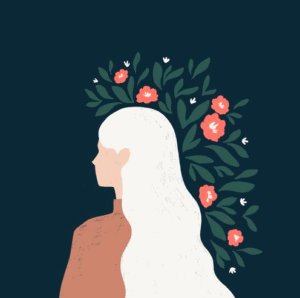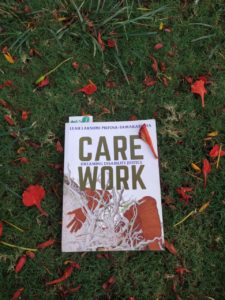
Art by Madeline Kate Martinez
“What do you think healing is? Is it that you will become as close to able bodied as possible?” This line hit me in my gut. As someone who has lived with chronic illnesses (Fibromyalgia and Complex Post Traumatic Stress Disorder) that cause pain and fatigue for more than four years, I have thought about healing a lot. It began primarily with my engagement with the medical-industrial complex – in the hunt for a name to the illness and maybe relief from the consistent pain.
One of the troubles with living with an ‘invisible’ illness is that I heard a lot from doctors that the pain was inside my head. One time, the doctor referred to me as stubborn and wanting to remain ill. Convinced that she was right, I walked the five kms home. I had swollen feet and aching knees for a couple of weeks after. Hearing doctors doubt my pain was the most common experience. “Is it really that bad?” “It is all in your head”, “I am sure if you meditate, you will feel better”.
To protect myself from the fear of being dismissed, I began to not talk about it.
Thus, began a journey of doubt, disbelief and hatred towards my body-mind that I was confident was failing me. I coped in the best ways I could. I quit full time jobs; I began working from bed; I surrounded my bed with things that gave me comfort like hot water packs, tarot cards and candles. Of course, my medicines were always within arms reach. I revealed, to others, only as much as I absolutely needed to.
At the same time, I dove head first into literature written by chronically ill people across the world; stories and narratives about being in pain, about living and loving gloriously. Quite similarly I turned to Twitter to find many people speaking about their illness honestly and holding space for others. Building a space for conversation on different kinds of bodies. As my pain and isolation grew, I held onto chronically ill twitter with every fibre of my being. Slowly, I found resonance; I found language; I found friends.
Yet, the significant evolution in my internal and external language from one of loss to one of richness happened as I made my way through Care Work: Dreaming Disability Justice by Leah Lakshmi Piepzna-Samarasinha. In her marvellous collection of essays about healing, care and justice, Lambada Literary Award-winning writer and longtime activist and performance artist Piepzna-Samarasinha maps communities of care, the principles of disability justice and creates a roadmap of how to extend solidarity, care and access to fellow chronically ill and disabled people. In other words, the book highlights the feeling of isolation that comes with being ill and how being held – from near and far – by others whose experiences resonate heals the heart bit by bit.

Art by Giulia Rosa
Being ill and confined to your home can be isolating. You lose many friends. You forget even more. You are forgotten because you never made it to that wedding or that late night party.
However, through the process of being ill, I also gained friends. Friends who went from ‘Twitter friends’ to companions in good times and bad. Seeing their timelines, their honesty and their kindness helped to build bonds. We exchanged photos that helped us cope and words of support that understood the underlying despair of illness. Online, I made friends who would text me from their beds; who knew epsom salts helped feet soreness; who sent me packages of care. I had experienced this web of care, the gentleness of the illness and disability community before I began to read Piepzna-Samarasinha’s Care Work. Yet, reading Care Work was about validation of these experiences. About being seen. About naming this community and web of care as intelligence and as home.
Piepzna-Samarasinha calls it Crip Emotional Intelligence – the ways in which disabled and sick people react to pain, anxiety and care for each other through it. She says: “It’s not assuming. Anything. It’s always asking: if you can touch, what you call your body or your sick, what you need, if you even want suggestions for your issue or if you just want listening. It’s understanding that each disabled person is the expert on their own body/mind.”
Reading this I learnt that sometimes our life hacks are survival techniques, responses to the world, our everyday resistance to difficult situations and trauma. It led me to ask, how better can we hold space for each other? How better can we care? How better can these hacks be transformed into shared knowledge for healing and repair?
How can we articulate our everyday responses, to ourselves and each other, as intelligence, knowledge gained from living in an ableist world?
I had a massive PTSD trigger recently and felt my body close up in a way that I thought was behind me. My very first thought was: I haven’t healed. Despite the years in therapy, I am still broken. I caught my thoughts before they spiralled and curled up with Care Work instead. Here, I found these words: “It is so difficult to write both what sucks about disability – the pain, the oppression, the impairment – and the joy of this body at the same time. The joy of this body comes from Crip community and interdependence, but most of all, of the hard beauty of this life, built around all the time I must spend resting. The bed is the nepantla place of opening.”
It is so easy to feel crazy and alone in this world. I flip through my Instagram and someone has posted a photo about growing old and needing support in the bathroom. I think to myself, I need support in the bathroom on some days and others I pass as able bodied. This person doesn’t realize that their shame at growing old is a reality for some of us at a younger age. Sometimes I can’t shower for days because I decide to exchange all the energy I have in a day to make myself a meal. So how do I understand my experiences on the spectrum of needing support and being “able” to go to the bathroom alone, without accommodations?
Being chronically sick is a hard fight and sometimes it feels like the fight never ends. Piepzna-Samarasinha writes: “The transition itself, of becoming disabled or moving along the ability spectrum, is frequently invisibilized, to the point that these changes do not even have a name. Of course there aren’t yet words for this. Without crip intervention, we are frequently left alone to figure out how to be in our bodyminds and in this ableist world.”
In so many ways I felt alone till I found other ill friends. A year ago, on my birthday, I received a package. I opened it, and inside was a box of multivitamins. There was no name on the package, but without hesitating I picked up my phone and texted my chronically ill friend Anna: “Thank you for the medicines. So thoughtful <3” Who else would send me vitamins to reduce my pain and fatigue?
Similarly, I receive packages from my other ill friend R. Once, she sent calming tea for the night and some cat stickers. I smiled at how well she knew me. We had only met a handful of times in “real life”, but a little while ago, we spent some time together at a feminist conference. We were holed up in a hotel room where she lay on the bed and talked. We spoke about upset stomachs, sleepless nights, of bodies that were too tired to walk to the airport gate without a buggy (a buggy that we were both refused, since we “don’t look sick”). These conversations felt natural. There was no judgment and no solutions. Just care and comfort.
One of the struggles I have had in life has been about being the “good disabled person”. The deficiency model of disability is something Piepzna-Samarasinha spends several chapters unpacking. She challenges the dominant idea that we (disabled and sick people) want a cure; we want healing that helps us attain a perfect balance of “normal”; a balance which allows us to participate in society – just like anybody else would. She highlights how when disabled and sick people need support or our lives our not solution focussed, we are seen as being stubborn or wanting to remain ill.
For so long, I felt I was not enough. I didn’t realise that my community of ill friends and disabled people was rich, vibrant and happy, despite being in pain. The pain had consumed me and my identity. I was nothing but my illness or disability. Reading Care Work helped shift my thoughts away from this deficiency model to one of beauty, resistance and resilience. It allowed me to hold within my body all these different aspects of being, living and loving.
During the same conference, I had a sudden dip in energy and texted R. She replied promptly: please go to your room and rest. I already knew that was the answer, but I felt guilt. Guilt that I wasn’t “able bodied enough” to attend the full conference. Guilt that there was particular way to be and I was failing at it. But I also felt grateful for her message.
So often society presents to us unimaginable standards of efficiency: travel to new places, bag book deals, commute to work. In the face of this, I feel alone and wonder about the number of hours I spend in bed, unwashed. This too, Piepzna-Samarasinha speaks about: “When you feel too crazy to make it to the pretty dance party, you may feel there is no place for you at all. when you don’t know – because it is systematically invisibilized – that there is a queer crip community happening in beds, living rooms, coffee shops, on Skype, and it counts just as much. I’ve had my life saved by prioritising queer disabled people of colour friendship. But I know that most non-disabled QTBIPOC community has no idea that disabled queer of colour communities exist.”
Reading books on care, participating in the disability rights movement and actively asking for accommodations has helped change the narrative inside my head. I find the way care is shared in the chronically ill community to be marvellous. Like the number of times I’ve texted friends to say I threw up, and their response is to hydrate or to sleep it off. These friends know that trips to doctors often mean unnecessary frustration, and the dismissal of lived experiences. Being part of disabled spaces and the illness community has helped me unpack my internalised ableism and ideas of “normal”: that there is no one way to participate in conferences, meetings or activism.
In Care Work, Piepzna-Samarasinha weaves a narrative in response to the fast paced, capitalist, perfection rewarding world; a narrative that reminds me that I am valuable. The richness in my life, albeit slow and from the comfort of my bed, was illuminated by this collection of essays, through which I learned that I am not fixed, but ‘I am living a life worth living.’ So much of my time is spent in bed, but I can live a luscious world from there. Piepzna-Samarasinha gave me the language to not erase my experiences, but to be proud of my knowledge and intelligence, and to extend care webs to others like me.

Image by Srinidhi
Srinidhi first spoke to Kaha Mind about her journey in The Body Keeps Score.
About the author-
Srinidhi works on women’s rights, child rights and on disability. She is an introvert, loves poetry, writing and cats+dogs.
